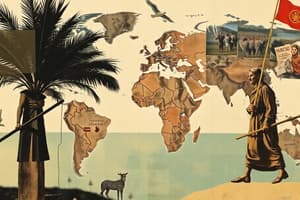Podcast
Questions and Answers
Which scenario exemplifies the exploitation of labor as described in the text?
Which scenario exemplifies the exploitation of labor as described in the text?
- A non-profit organization employing local artisans to produce handicrafts, ensuring fair wages and safe working conditions.
- A multinational corporation establishing a factory in a country with minimal environmental regulations to reduce pollution control costs regardless of human costs. (correct)
- A tech company offering remote positions to workers in developing countries at competitive wages.
- A local business owner hiring teenagers for summer jobs at minimum wage.
The collapse of the Rana Plaza garment factory in Bangladesh primarily illustrates which of the following aspects of global labor practices?
The collapse of the Rana Plaza garment factory in Bangladesh primarily illustrates which of the following aspects of global labor practices?
- The positive impact of fast fashion on the economic development of Bangladesh.
- The prioritization of worker well-being and safety over corporate profits in developing nations.
- The effectiveness of international labor regulations in protecting worker safety.
- The potential for severe consequences when companies prioritize cost-cutting measures over worker safety. (correct)
What is the most likely outcome for American workers when companies choose to outsource labor to countries with weaker labor laws?
What is the most likely outcome for American workers when companies choose to outsource labor to countries with weaker labor laws?
- A surge in demand for specialized skills, leading to higher salaries for skilled American workers.
- An improvement in working conditions in the U.S. due to the adoption of international labor standards.
- An increase in wages for American workers due to reduced competition.
- A decrease in domestic job opportunities and potential wage stagnation for American workers. (correct)
If a company decides to move its production from the United States to a country with significantly lower labor costs, which statement is the most probable?
If a company decides to move its production from the United States to a country with significantly lower labor costs, which statement is the most probable?
What is the role of weak labor laws in the exploitation of workers, according to the text?
What is the role of weak labor laws in the exploitation of workers, according to the text?
According to the information provided, what is the primary reason many garment workers in Bangladesh are trapped in a cycle of poverty?
According to the information provided, what is the primary reason many garment workers in Bangladesh are trapped in a cycle of poverty?
Which of the following statements best reflects the impact of global outsourcing on U.S. manufacturing jobs since 2000?
Which of the following statements best reflects the impact of global outsourcing on U.S. manufacturing jobs since 2000?
According to the International Labour Organization (ILO), what is a significant issue faced by women in global garment production?
According to the International Labour Organization (ILO), what is a significant issue faced by women in global garment production?
How does the prioritization of the cheapest labor by companies affect workers in wealthier countries?
How does the prioritization of the cheapest labor by companies affect workers in wealthier countries?
What is a key characteristic of the 'race to the bottom' in the context of global labor practices?
What is a key characteristic of the 'race to the bottom' in the context of global labor practices?
Why does gratitude from workers in less-developed countries not necessarily justify low wages and poor working conditions?
Why does gratitude from workers in less-developed countries not necessarily justify low wages and poor working conditions?
What is the main point of the Cambodian garment workers' protests in 2014?
What is the main point of the Cambodian garment workers' protests in 2014?
What distinguishes real economic development from mere job creation in less-developed countries?
What distinguishes real economic development from mere job creation in less-developed countries?
What is a key way in which many global systems perpetuate poverty in less-developed countries?
What is a key way in which many global systems perpetuate poverty in less-developed countries?
How do fair trade organizations contribute to economic development?
How do fair trade organizations contribute to economic development?
Why is imagining a scenario of foreign company exploitation in a developed country helpful in understanding global labor issues?
Why is imagining a scenario of foreign company exploitation in a developed country helpful in understanding global labor issues?
What did the Triangle Shirtwaist Factory Fire in 1911 demonstrate about labor conditions in the early 1900s?
What did the Triangle Shirtwaist Factory Fire in 1911 demonstrate about labor conditions in the early 1900s?
What does the statistic about global wage differences indicate about the garment industry?
What does the statistic about global wage differences indicate about the garment industry?
According to Fair Trade International, what long-term impacts do workers in fair trade-certified factories experience?
According to Fair Trade International, what long-term impacts do workers in fair trade-certified factories experience?
How did the Cambodian government respond to garment worker's protests?
How did the Cambodian government respond to garment worker's protests?
What is the estimate of the percentage of the global workforce that works in manufacturing?
What is the estimate of the percentage of the global workforce that works in manufacturing?
In the early 1900s, how many hours a week did factory workers in the U.S. work, on average?
In the early 1900s, how many hours a week did factory workers in the U.S. work, on average?
Why do fairtrade factories in India provide educational programs in addition to providing a living wage?
Why do fairtrade factories in India provide educational programs in addition to providing a living wage?
Flashcards
Exploitative Labor
Exploitative Labor
Working long hours in unsafe conditions for very low pay, trapping workers in poverty.
Rana Plaza Collapse
Rana Plaza Collapse
A garment factory collapse in Bangladesh in 2013, killing over 1,100 workers due to unsafe conditions.
Global Outsourcing
Global Outsourcing
Moving production overseas to countries with weaker labor laws to reduce costs.
U.S. Manufacturing Job Loss
U.S. Manufacturing Job Loss
Signup and view all the flashcards
Weak Labor Laws
Weak Labor Laws
Signup and view all the flashcards
Lack of Worker Power
Lack of Worker Power
Signup and view all the flashcards
Living Wage
Living Wage
Signup and view all the flashcards
International Labour Organization (ILO)
International Labour Organization (ILO)
Signup and view all the flashcards
Race to the Bottom
Race to the Bottom
Signup and view all the flashcards
Gratitude vs. Fairness
Gratitude vs. Fairness
Signup and view all the flashcards
Real Economic Development
Real Economic Development
Signup and view all the flashcards
Labor Law Exploitation
Labor Law Exploitation
Signup and view all the flashcards
Garment Worker Wages
Garment Worker Wages
Signup and view all the flashcards
Fair Trade
Fair Trade
Signup and view all the flashcards
The True Cost of Fast Fashion
The True Cost of Fast Fashion
Signup and view all the flashcards
Exploitation of Garment Workers
Exploitation of Garment Workers
Signup and view all the flashcards
Asia Floor Wage Alliance
Asia Floor Wage Alliance
Signup and view all the flashcards
Resource Extraction
Resource Extraction
Signup and view all the flashcards
Cambodian Garment Worker Protests (2014)
Cambodian Garment Worker Protests (2014)
Signup and view all the flashcards
Ethical Consumption
Ethical Consumption
Signup and view all the flashcards
Good On You
Good On You
Signup and view all the flashcards
Fashion Checker
Fashion Checker
Signup and view all the flashcards
Study Notes
- Exploitation in labor is about fairness and power, not just having a job.
- Working long hours in unsafe conditions for minimal wages traps workers in poverty.
Global Labor Exploitation
- Workers in factories in countries like Bangladesh and Vietnam often earn $2–$3 a day, which falls well below a living wage.
- Billion-dollar corporations outsource labor to countries with weak labor laws to maximize profit while paying workers the absolute minimum.
- Workers lack the power to negotiate for better wages or conditions, perpetuating a cycle of poverty.
Rana Plaza Collapse (Bangladesh, 2013)
- A garment factory building collapsed, resulting in over 1,100 deaths and more than 2,500 injuries.
- Workers were forced to work despite noticing large cracks in the building, under threat of losing their jobs.
- The demand for fast fashion from brands like Walmart, Primark, and H&M drives the need for cheap labor.
- Garment workers in Bangladesh earn approximately $75 a month, while the estimated living wage is $200–$250.
- Approximately 85% of workers in global garment production are women, who face frequent harassment, discrimination, and unsafe conditions.
Impact on American Workers
- Global outsourcing takes away potential job opportunities for American workers,
- Companies moving production overseas for cheaper labor undercuts wages and job opportunities for workers in the U.S.
- Factory closures result in suffering communities.
- Since 2000, the U.S. has lost over 5 million manufacturing jobs due to companies relocating to countries with cheaper labor.
- The Midwest, including Minnesota, was significantly affected by outsourcing, with factory shutdowns in towns like Duluth and St. Cloud.
- From 1998 to 2010, U.S. clothing manufacturing employment decreased drastically by 82%.
- Wages for American manufacturing workers have stagnated or decreased in industries with common outsourcing practices.
Global Competition
- Prioritizing the cheapest labor pressures all workers globally to accept worse conditions and lower pay.
- Companies move production to countries with the weakest labor laws, such as factories shifting from China to Bangladesh, Cambodia, and Ethiopia.
- Global competition lowers wage standards and weakens job security for workers everywhere, even in developed countries.
- Approximately 8% of the global workforce is in manufacturing, many under exploitative conditions.
Fairness and Gratitude
- The mere presence of gratitude does not make labour practices fair.
- Exploiting desperation is not justified, even if someone is grateful for a job.
Cambodian Garment Workers Protests (2014)
- Workers protested for a living wage increase from $100 to $160 per month.
- The Cambodian government responded with violent crackdowns, resulting in deaths and injuries.
- Workers were punished for demanding fair wages and safer working conditions.
- Many garment workers in Asia earn less than half of a living wage.
Real Economic Development
- True economic development includes providing education, fair wages, and opportunities to improve lives.
- Global systems often perpetuate poverty in poor countries, with corporations extracting cheap labor and resources without investing in local infrastructure, schools, or healthcare..
- Countries could build systems beneficial to their own people if they had more control over their own economies.
Fair Trade
- Fair trade organizations work directly with communities to ensure fair wages and access to healthcare and education.
- Fair trade factories in the textile industry in India pay workers living wages and offer educational programs for their children.
- Workers in fair trade-certified factories report improved health, education, and living conditions, compared to conventional sweatshops.
Early U.S. Factory Exploitation
- In the early 1900s, American workers faced similar exploitation, working 12-16 hour days in dangerous conditions.
- The Triangle Shirtwaist Factory Fire (1911) in New York resulted in the deaths of 146 garment workers due to being locked in during their shifts.
- Labor reforms following this tragedy proved that having a job does not equate to being treated fairly.
- Before labor laws improved, the average factory worker in the U.S. worked over 60 hours a week with little pay or protections.
Studying That Suits You
Use AI to generate personalized quizzes and flashcards to suit your learning preferences.





